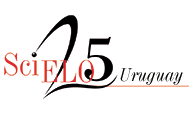Editorial process
All submissions to the Studies and Articles sections are peer-reviewed (double-blind) according to the following editorial process.
Receipt of the manuscript
Authors send the manuscript through the OJS platform indicating which section it is addressed to (Studies or Articles).
Initial review by the Editorial Board
This initial review verifies that the article complies with the editorial standards and assesses its relevance, originality and suitability to the journal's profile.
The Editorial Secretary carries out a preliminary evaluation of the text, examining compliance with formal aspects and citation standards (in accordance with the Chicago Manual of Style); he/she applies the anti-plagiarism system to the manuscript to verify that it is original and unpublished. Once this stage has been completed, it requests the review of the text by members of the Editorial Board, according to the discipline concerned. The aim of this review will be to ensure the minimum quality criteria for the work to be sent to blind peers or, failing that, to reject it. Within ten (10) days the author will be notified whether the manuscript is accepted or rejected for evaluation by the external reviewers. In the latter case, the communication of the editorial decision will include a brief written justification.
If the text has only formal defects, such as those resulting from ignorance of some aspect of the rules for contributors, the author will be asked to make the appropriate modifications.
In the case of originals addressed to the Studies section, after preliminary review by the Editorial Secretary, the manuscript is sent to the Associate Editor in his capacity as head of the section, who must comply with the same functions and procedures described above for the Editorial Board in the case of articles.
Assignment of reviewers and peer review (double-blind)
The members of the Editorial Board or Associate Editors, as appropriate, must communicate to the journal's secretariat the names of the reviewers who will be involved in the review process of each of the texts. For this purpose, two reviewers who are experts in the subject of the manuscript will be selected. The review is anonymous (double-blind) and the deadline for submission of the evaluation report is 30 days. The reviewers may propose
- a) Accept without modifications or with some modifications (minor changes).
- b) Publishable with substantial modifications
- c) Reject (not to publish).
Decision of the Editorial Board
If the evaluations of the same manuscript (intended for either of the two sections) coincide in their recommendation, a decision is made based on them.
If there are contradictions or difficulties in guiding the author of a text, a third reviewer is assigned.
In some cases, the Editorial Board, on the basis of all the information provided by the reports, may decide that the article is not publishable even though one of the reports has found the work to be publishable.
Third review (if necessary)
The third reviewer analyses the manuscript and issues a report within 30 days. The Editorial Board makes a final decision on the basis of the three reports.
In justified cases, further peer review may be requested.
Communication with the author and sending of corrected version
The reports and the editorial decision (acceptance, revision or rejection) are sent to the author. If modifications or revision of any particular aspect is required, the author has a period of 1 month to send the corrected version.
Review of changes and final approval
The Editorial Board or the Associate Editor, as appropriate, verifies that the requested changes have been incorporated. If not, it ensures that the authors provide adequate justification for the omission of such changes. If necessary, the Editorial Board may ask one of the reviewers of the article or study to review the changes made.
Final review and publication
Once the text has been given final approval, it is proofread and formatted.
The author receives his or her typeset work for proofreading.
When the technical production is completed, the work is uploaded to the current issue in accordance with the continuous publication mode.






















 This work is under a
This work is under a 